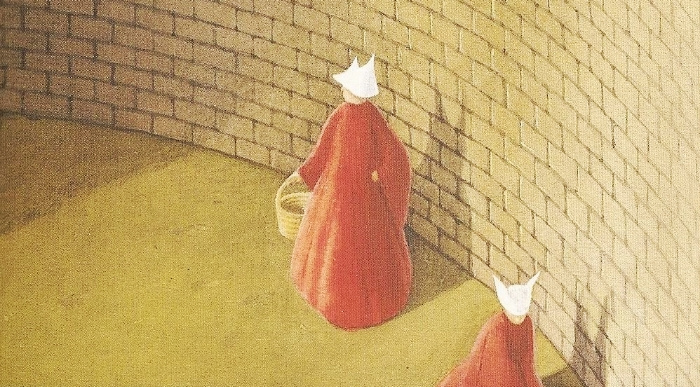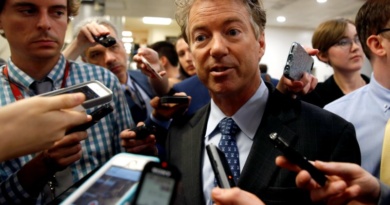Why Women Are Dressing Up As Margaret Atwood’s Handmaids
Cordelia Freeman, University of Nottingham
Margaret Atwood’s novel The Handmaid’s Tale has remained popular since its publication in 1985. It has been translated into dozens of languages, made into a film in 1990, and even became a ballet and an opera. It is read in schools the world over. Most recently, there has been a new wave of interest in the dystopian story thanks to the TV adaptation by MGM and Hulu.
However, it isn’t the adaptation alone that has caused this popularity, the novel has seen a reported 200% increase in sales since Donald Trump was elected as US president.
The series takes place in the fictional nation state of Gilead (established in North America after an uprising has overthrown the US government and murdered the US president and Congress). There, a Christian theocracy has dealt with a global fertility crisis by enslaving fertile women. They are systematically raped by high-ranking officials in order to bear children for the new nation. Filmed during the 2016 election race, the cast and crew has since spoken about how political events gave a whole new weight to the series.
And since the series has been aired, it has fed back into politics. Women have been dressing as handmaids to express their anger, frustration and dissent in a relatable and visually striking way. By dressing in these instantly recognisable costumes the handmaids have been bearing witness to federal and state attempts to limit women’s reproductive choices.
While there are some clear differences between Atwood’s Gilead and Trump’s current US administration (for one, climate change is a government priority in Gilead), increasing threats to women’s reproductive rights in the US have led protestors to adopt the message and aesthetic of The Handmaid’s Tale.
Placards have been spotted at anti-Trump protests bearing slogans such as “The Handmaid’s Tale is not an instruction manual” and “Make Margaret Atwood fiction again”.
Women brought up in certain communities in the US have also been drawing similarities between their experiences and The Handmaid’s Tale. One described a movement called Quiverfull, which raises women to be “helpmeets”, their purpose being to meet the needs of their husbands. The group is preparing for “the culture wars”, when they think they will have to uphold far-right evangelical christian values against attack. For these women, Atwood’s Gilead feels all-too familiar.
Atwood herself has stated that far from being an imagined alternate universe, her book draws on real historical laws that have subjugated women and valued their childbearing abilities above all else. She calls the book “speculative fiction” rather than “science fiction”.
But the world depicted by The Handmaid’s Tale is feeling less and less speculative. Particularly troubling examples include Senate bills in Ohio and Texas that would restrict women’s right to an abortion. These bills would effectively ban a safe and effective medical procedure in the second trimester and allow doctors to withhold information on the health of the foetus.
To protest these bills women dressed as handmaids and entered the Ohio and Texas senates. They stayed in character, walking the halls and listening to the debates in silence. The women were not asked to leave.
Trump has signed legislation allowing states to cut funding to Planned Parenthood, a family planning organisation that also provides abortions. The availability of abortions in the US is already at a historic low. While Trump was previously pro-choice, he has declared himself pro-life since 2011.
A visual spectacle
The striking aesthetic of the handmaids has clear visual appeal for protesters. Clothes signify a woman’s status in Gilead and the women singled out for their fertility are dressed in flowing red cloaks with large white bonnets to cover their hair and blinker them to the outside world. The series’ costume designer Ane Crabtree wanted the handmaids to look like “walking wombs”.
Atwood has explained the symbolism of the handmaid’s clothing saying “the handmaids wear red, from the blood of parturition, but also from Mary Magdalene. Also, red is easier to see if you happen to be fleeing”.
When the protesting handmaids turned up at the Texas and Ohio Senates in their shocking red robes and white bonnets, they brought the bills being debated inside into public consciousness.
It’s not just protesters who are aware of the power of such imagery. Joseph Fiennes, who plays a powerful commander in Gilead and is the owner of the series’ protagonist, Offred (played by Elizabeth Moss) has said that when he saw images of women dressed as handmaids ”my jaw was on the ground“. Moss herself said that it’s "an image that stands so clearly for feminism and women’s rights. I don’t know many costumes or outfits in literature that someone could wear into an assembly and you immediately know why they’re there and what side they’re on.”
All the handmaid protests so far have taken place in the US. But with the anti-choice Democratic Unionist Party now holding the balance of power in the UK parliament – and with restrictive abortion laws in Ireland and Poland – it perhaps won’t be long before handmaids start appearing in other countries. The picture is even starker outside Europe.
Despite the protests, restrictive laws are becoming reality. The Ohio governor has agreed to ban abortions after 20 weeks and the Texan Bill has moved onto the state senate for a vote.
The real-life handmaids are our reminder of what is at stake. Atwood has noted that the handmaids protest because “somebody has to tell the Republicans the Handmaid’s Tale is not a blueprint”.
![]() As women’s rights continue to be threatened, we may see more handmaids cropping up – warning us not to sleepwalk into Gilead.
As women’s rights continue to be threatened, we may see more handmaids cropping up – warning us not to sleepwalk into Gilead.
Cordelia Freeman, Teaching Associate in Human Geography, University of Nottingham
This article was originally published on The Conversation. Read the original article.





